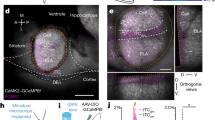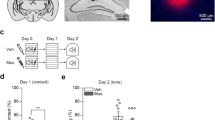Abstract
Rationale
The precise neural circuitry that encodes fear memory and its extinction within the brain are not yet fully understood. Fearful memories can be persistent, resistant to extinction, and associated with psychiatric disorders, especially post-traumatic stress disorder (PTSD). Here, we investigated the microtopography of neurons activated during the recall of an extinguished fear memory, as well as the influence of time on this microtopography.
Methods
We used the plasticity-related phosphorylated mitogen-activated protein kinase (pMAPK) to identify neurons activated in the recall of consolidated and extinguished auditory Pavlovian fear memories in rats. Quantitatively matched brain regions were used to investigate activity in the amygdala and prefrontal cortex.
Results
Recall of a consolidated, nonextinguished auditory fear memory resulted in a significantly greater number of activated neurons located in the dorsolateral subdivision of the lateral amygdala (LADL) when recalled 24 h after consolidation but not when recalled 7 days later. We found that the recall of an extinction memory was associated with pMAPK activation in the ventrolateral subdivision of the lateral amygdala (LAVL). Next, we showed that the pattern of pMAPK expression in the prelimbic cortex differed spatially following temporal variation in the recall of that memory. The deep and superficial layers of the pre-limbic cortex were engaged in recent recall of a fear memory, but only the superficial layers were recruited if the recall occurred 7 days later.
Conclusions
Collectively, our findings demonstrate a functional microtopography of auditory fear memory during consolidation and extinction at the microanatomical level within the lateral amygdala and medial prefrontal cortex.








Similar content being viewed by others
References
Adams JP, Sweatt JD (2002) Molecular psychology: roles for the ERK MAP kinase cascade in memory. Annu Rev Pharmacol Toxicol 42:135–163
Albrecht A, Stork O (2017) Circadian rhythms in fear conditioning: an overview of behavioral, brain system, and molecular interactions. Neural Plast 2017:1–12
Baker KD, Bisby MA, Richardson R (2016) Impaired fear extinction in adolescent rodents: behavioural and neural analyses. Neurosci Biobehav Rev 70:59–73
Benjamini Y, Hochberg Y (1995) Controlling the false discovery rate: a practical and powerful approach to multiple testing. J R Stat Soc Ser B Methodol:289–300
Bergstrom HC, Johnson LR (2014) An organization of visual and auditory fear conditioning in the lateral amygdala. Neurobiol Learn Mem 116:1–13
Bergstrom HC, McDonald CG, Johnson LR (2011) Pavlovian fear conditioning activates a common pattern of neurons in the lateral amygdala of individual brains. PLoS One 6:e15698
Bergstrom HC, McDonald CG, Dey S, Fernandez GM, Johnson LR (2013a) Neurons activated during fear memory consolidation and reconsolidation are mapped to a common and new topography in the lateral amygdala. Brain Topogr 26:468–478
Bergstrom HC, McDonald CG, Dey S, Tang H, Selwyn RG, Johnson LR (2013b) The structure of Pavlovian fear conditioning in the amygdala. Brain Struct Funct 218:1569–1589
Blanchard RJ, Blanchard DC (1969) Passive and active reactions to fear-eliciting stimuli. J Comp Physiol Psychol 68:129–135
Bloodgood DW, Sugam JA, Holmes A, Kash TL (2018) Fear extinction requires infralimbic cortex projections to the basolateral amygdala. Transl Psychiatry 8:60
Bouton ME, King DA (1983) Contextual control of the extinction of conditioned fear: tests for the associative value of the context. J Exp Psychol Anim Behav Process 9:248–265
Brambilla R et al (1997) A role for the Ras signalling pathway in synaptic transmission and long-term memory. Nature 390:281
Bukalo O, Pinard CR, Silverstein S, Brehm C, Hartley ND, Whittle N, Colacicco G, Busch E, Patel S, Singewald N, Holmes A (2015) Prefrontal inputs to the amygdala instruct fear extinction memory formation. Sci Adv 1:e1500251
Cestari V, Rossi-Arnaud C, Saraulli D, Costanzi M (2014) The MAP (K) of fear: from memory consolidation to memory extinction. Brain Res Bull 105:8–16
Corcoran KA, Quirk GJ (2007) Activity in prelimbic cortex is necessary for the expression of learned, but not innate, fears. J Neurosci 27:840–844
De Smith MJ, Goodchild MF, Longley P (2007) Geospatial analysis: a comprehensive guide to principles, techniques and software tools. Troubador publishing ltd
Delamater AR, Westbrook RF (2014) Psychological and neural mechanisms of experimental extinction: a selective review. Neurobiol Learn Mem 108:38–51
Do-Monte FH, Manzano-Nieves G, Quiñones-Laracuente K, Ramos-Medina L, Quirk GJ (2015) Revisiting the role of infralimbic cortex in fear extinction with optogenetics. J Neurosci 35:3607–3615
Duvarci S, Pare D (2014) Amygdala microcircuits controlling learned fear. Neuron 82:966–980. https://doi.org/10.1016/j.neuron.2014.04.042
Faliagkas L, Rao-Ruiz P, Kindt M (2018) Emotional memory expression is misleading: delineating transitions between memory processes. Curr Opin Behav Sci 19:116–122
Fanselow MS (1984) What is conditioned fear? Trends Neurosci 7:460–462
Fanselow MS, Gale GD (2003) The amygdala, fear, and memory. Ann N Y Acad Sci 985:125–134. https://doi.org/10.1111/j.1749-6632.2003.tb07077.x
Fendt á, Fanselow M (1999) The neuroanatomical and neurochemical basis of conditioned fear. Neurosci Biobehav Rev 23:743–760
Hebb Donald (1949) The Organization of Behavior. New York: Wiley & Sons
Herry C, Trifilieff P, Micheau J, Lüthi A, Mons N (2006) Extinction of auditory fear conditioning requires MAPK/ERK activation in the basolateral amygdala. Eur J Neurosci 24:261–269
Johnson LR, McGuire J, Lazarus R, Palmer AA (2012) Pavlovian fear memory circuits and phenotype models of PTSD. Neuropharmacology 62:638–646
Laurent V, Westbrook RF (2009) Inactivation of the infralimbic but not the prelimbic cortex impairs consolidation and retrieval of fear extinction. Learn Mem 16:520–529
LeDoux J, Daw ND (2018) Surviving threats: neural circuit and computational implications of a new taxonomy of defensive behaviour. Nat Rev Neurosci 19:269–282. https://doi.org/10.1038/nrn.2018.22
Lee HJ, Haberman RP, Roquet R, Monfils MH (2016) Extinction and retrieval+extinction of conditioned fear differentially activate medial prefrontal cortex and amygdala in rats. Front Behav Neurosci 9. https://doi.org/10.3389/fnbeh.2015.00369
Little JP, Carter AG (2012) Subcellular synaptic connectivity of layer 2 pyramidal neurons in the medial prefrontal cortex. J Neurosci 32:12808–12819
Liu X, Ramirez S, Pang PT, Puryear CB, Govindarajan A, Deisseroth K, Tonegawa S (2012) Optogenetic stimulation of a hippocampal engram activates fear memory recall. Nature 484:381
Mamiya N, Fukushima H, Suzuki A, Matsuyama Z, Homma S, Frankland PW, Kida S (2009) Brain region-specific gene expression activation required for reconsolidation and extinction of contextual fear memory. J Neurosci 29:402–413
Marek R, Jin J, Goode TD, Giustino TF, Wang Q, Acca GM, Holehonnur R, Ploski JE, Fitzgerald PJ, Lynagh T, Lynch JW, Maren S, Sah P (2018) Hippocampus-driven feed-forward inhibition of the prefrontal cortex mediates relapse of extinguished fear. Nat Neurosci 21:384–392
Maren S (2001) Neurobiology of Pavlovian fear conditioning. Annu Rev Neurosci 24:897–931
Maren S (2011) Seeking a spotless mind: extinction, deconsolidation, and erasure of fear memory. Neuron 70:830–845
Maren S, Quirk GJ (2004) Neuronal signalling of fear memory. Nat Rev Neurosci 5:844–852
Milad MR, Quirk GJ (2002) Neurons in medial prefrontal cortex signal memory for fear extinction. Nature 420:70–74
Milad MR, Quirk GJ (2012) Fear extinction as a model for translational neuroscience: ten years of progress. Annu Rev Psychol 63:129–151
Nader K, Schafe GE, LeDoux JE (2000) Reply—Reconsolidation: the labile nature of consolidation theory. Nat Rev Neurosci 1:216–219
Pape HC, Pare D (2010) Plastic synaptic networks of the amygdala for the acquisition, expression, and extinction of conditioned fear. Physiol Rev 90:419–463. https://doi.org/10.1152/physrev.00037.2009
Paxinos G, Watson C (2007) The rat brain in stereotaxic coordinates, vol 32. Qingchuan Zhuge translate People’s Medical Publishing House, Beijing
Quirk GJ (2002) Memory for extinction of conditioned fear is long-lasting and persists following spontaneous recovery. Learn Mem 9:402–407
Rescorla RA (1988) Behavioral studies of Pavlovian conditioning. Annu Rev Neurosci 11:329–352
Rescorla RA, Heth CD (1975) Reinstatement of fear to an extinguished conditioned stimulus. J Exp Psychol Anim Behav Process 1:88–96
Rumpel S, LeDoux J, Zador A, Malinow R (2005) Postsynaptic receptor trafficking underlying a form of associative learning. Science 308:83–88. https://doi.org/10.1126/science.1103944
Schafe GE, Atkins CM, Swank MW, Bauer EP, Sweatt JD, LeDoux JE (2000) Activation of ERK/MAP kinase in the amygdala is required for memory consolidation of pavlovian fear conditioning. J Neurosci 20:8177–8187
Schafe GE, Nader K, Blair HT, LeDoux JE (2001) Memory consolidation of Pavlovian fear conditioning: a cellular and molecular perspective. Trends Neurosci 24:540–546
Shin LM, Rauch SL, Pitman RK (2006) Amygdala, medial prefrontal cortex, and hippocampal function in PTSD. Ann N Y Acad Sci 1071:67–79
Smith KS, Bucci DJ, Luikart BW, Mahler SV (2016) DREADDS: use and application in behavioral neuroscience. Behav Neurosci 130:137–155
Van der Kolk BA (1994) The body keeps the score: memory and the evolving psychobiology of posttraumatic stress. Harv Rev Psychiatry 1:253–265
Vertes RP (2004) Differential projections of the infralimbic and prelimbic cortex in the rat. Synapse 51:32–58
Yehuda R (2002) Post-traumatic stress disorder. N Engl J Med 346:108–114
Acknowledgements
We gratefully acknowledge scholarship support from QUT Research Training Program [RTP] stipend. The authors wish to thank Dimitrios Vagenas for his helpful discussions and advice on statistical analysis.
Funding
This work was financially supported by the IHBI, QUT.
Author information
Authors and Affiliations
Corresponding author
Ethics declarations
All procedures were conducted in compliance with the Animal Welfare Unit, The University of Queensland Research, and Innovation Ethics Committee and the Research Ethics Committee of the Queensland University of Technology, Australia. Procedures complied with policies, regulations and ethical standards for animal experimentation, in accordance with the Queensland Government Animal Research Act 2001, associated Animal Care and Protection Regulations (2002 and 2008), and the Australian Code for the Care and Use of Animals for Scientific Purposes, 8th Edition
Conflict of interest
The authors declare that they have no conflict of interest.
Additional information
Publisher’s Note
Springer Nature remains neutral with regard to jurisdictional claims in published maps and institutional affiliations.
This article belongs to a Special Issue on Psychopharmacology of Extinction
Rights and permissions
About this article
Cite this article
Jacques, A., Chaaya, N., Hettiarachchi, C. et al. Microtopography of fear memory consolidation and extinction retrieval within prefrontal cortex and amygdala. Psychopharmacology 236, 383–397 (2019). https://doi.org/10.1007/s00213-018-5068-4
Received:
Accepted:
Published:
Issue Date:
DOI: https://doi.org/10.1007/s00213-018-5068-4




